220. TAKAHASHI Rakusai IV 高橋楽斎, 1925- , Shigaraki yunomi 信楽湯のみ (Shigaraki-ware teacup)
The Takahashi family has been a major producer of Shigaraki-wares since the early nineteenth century. Tozaemon, the founder of the lineage, was active from the 1820s and founded the Rakusai kiln around 1835. The third-generation Rakusai (1898-1976) was an important figure in the post-WWII preservation of traditional wood-fired unglazed potting in Shigaraki and a holder of a Shiga prefectural Living National Treasure title. The seller attributes this to Takahashi Rakusai IV. The fourth-generation holder of the title was named Mitsuo at birth, ascended to the Rakusai title in 1976 on the death of his predecessor, and held it until 2010, when he surrendered it to his son, the current and fifth-generation Rakusai. He was still an active potter at the age of 97 in 2022. The leaflet enclosed in the box is devoted to Takahashi Rakusai III. From the pictures of pots and boxes available online, the piece and the calligraphy and the seal stamped on the box resemble those of Takahashi Rakusai IV. The box in which this came does not appear to be over fifty years old. Rakusai IV is probably the correct attribution.
Light tan clay, wood-fired with kiln effects in the pinkish brown range, fly ash deposits, and vitrified natural ash glazing, with one bidoro tear. The base and the interior of the foot ring largely escaped the kiln effects, showing the natural color of the baked clay..Weight: 164 g (5.8 oz). Height: 7.6 cm (3 in). Width (at the widest point at the rim): 7.9 cm (3-1/8 in).
This sits on the flat foot ring, which is 4.4 cm (1-3/4 in) in diameter and roughly 0.8 cm (5/16 in) high on the exterior wall of the foot; the base of the foot ring is 0.3 cm (1/8 in) wide; and the area within the ring foot was hollowed out to roughly two-thirds of the depth of the foot. The interior is level and flat. The foot ring appears to have been trimmed on a wheel—the dimensions are very even. Above the foot, the walls move outward and upward in a straight line at about a 45-degree angle to a height of 1.3 cm (1/2 in). The artist’s seal, a small oval cartouche with characters inside (too tiny to read) was pressed into this area of the piece. The walls proper extend upward and outward at a steep angle in roughly a straight line. The exterior walls and the interior base of the cup show circular finger marks. A groove encircles the exterior, rising slowly up the cup in a continuous line as it moves around the exterior, to just below the rim. The surface of the piece is rough, like fine-grain sandpaper.
This was unglazed. On the front of the cup near the rim and extending downward about a third of the height of the cup is an area of vitrified natural ash glaze, dark greenish brown in color; at the right end of this area, a tear of molten glass (bidoro) formed and slid downward. The front of the cup and the area of the interior opposite the front are covered with the blackened remnants of some fly ash deposits. The back and the interior of the cup were largely unaffected by ash and are a pinkish brown color. Where the cup was exposed to more heat and flames, the color tends toward a darker, reddish brown.
This came with a box. The lid is inscribed in three lines: 信楽 (Shigaraki), 湯のみ (yunomi), and 楽斎 (Rakusai), with the artist’s seal stamped in red on the lower left. A potted biography of Takahashi Rakusai III was enclosed with the piece.
A nice example of how a skilled hand and a knowledgeable kiln operator can enhance an ordinary, everyday object.
Purchased from Treasures of Old Times, Bangkok, Thailand, June 2023 (invoice).












No comments:
Post a Comment